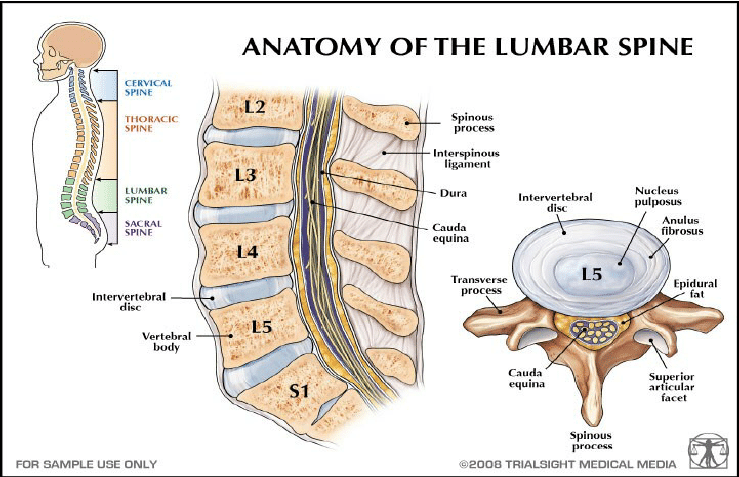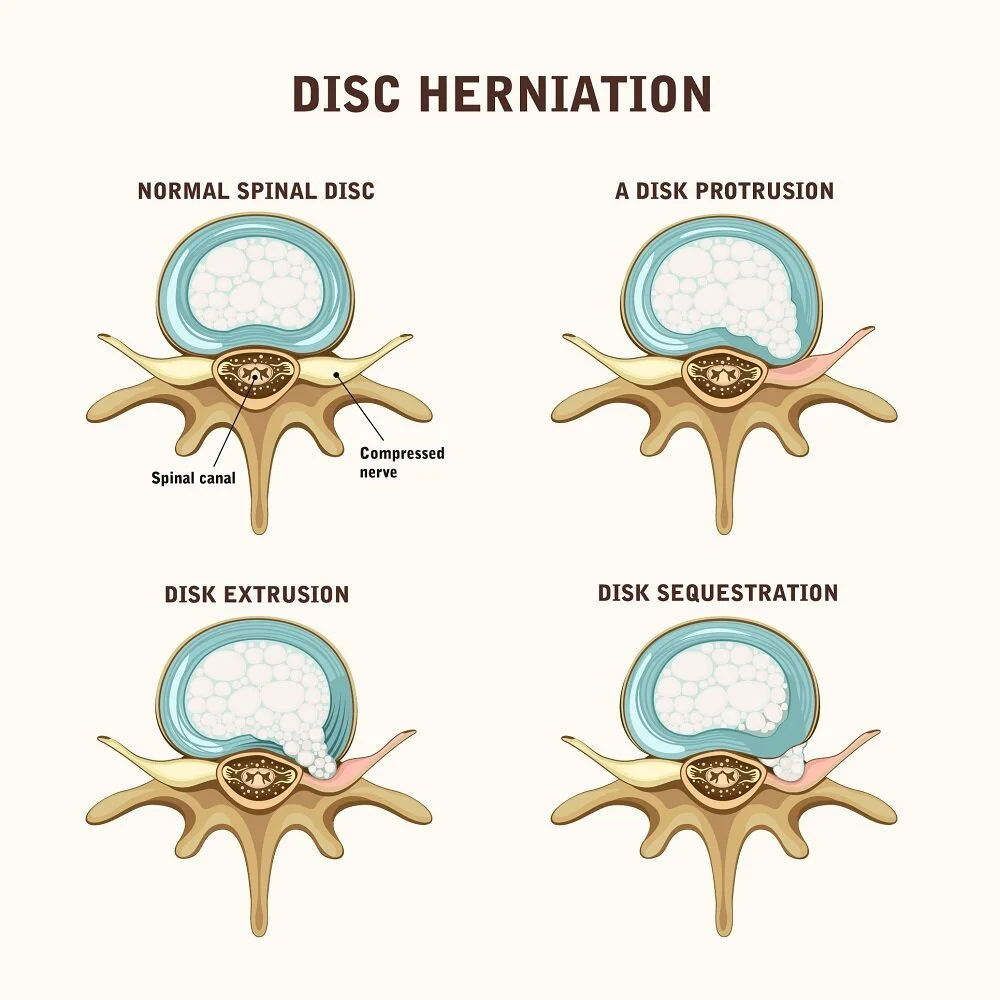Types of spinal disc herniation
Disc bulges, herniations, and extrusions may sound alarming, but what exactly do they entail? And how do they differ from one another?
By the end of this read, you'll hopefully gain a clearer understanding and be able to impress your family and friends with your newfound knowledge.
Before delving into the distinctions among these conditions, let's briefly review the anatomy of the spine. The diagram provided illustrates a cross-section of the five lumbar vertebrae, showcasing the intervertebral discs situated between them. These discs, which act as shock absorbers in the spine, are flat, cartilaginous structures. They possess a "viscous" nature, combining solidity with liquid-like properties, making them adaptable to loads and stresses. While resilient, they do undergo wear and tear over time.
Disc Bulge: Chances are you or someone close to you has been informed about a bulging disc in their spine. This is a frequently encountered occurrence in clinics, with many individuals unaware of it. Surprisingly, a significant portion of the general population harbors bulging discs without experiencing pain or limitations. Research indicates that even among individuals aged 20 without back pain, approximately 30% exhibit bulging discs, a figure that rises to 96% among 80-year-olds. This suggests that disc bulges are a normal part of aging and do not always correlate with pain.
Various analogies have been used to describe disc bulges, but essentially, it involves the disc inflaming and extending beyond its usual position. If the bulge doesn't impinge on any nerves or structures, it's unlikely to cause discomfort. However, if it does exert pressure on a nerve or causes inflammation, pain may ensue. The good news is that disc bulges can heal, with the outer structures of the disc remaining intact. With proper recovery measures, such as increased mobility and strength, the disc becomes stronger and more resilient, typically within a timeframe of 4 to 16 weeks.
Disc Herniation: A disc herniation occurs when there's a weakness in the outer structure of the disc, allowing the nucleus pulposus to protrude through the disc's outer wall. While some individuals with disc herniations remain asymptomatic, others may experience symptoms, particularly affecting nearby spinal structures. Common problems associated with disc herniation include sciatica, wherein the disc compresses the spinal cord.
Most cases of disc herniation are attributed to age-related degeneration, as the fluid and fibrous tissue within the disc weaken over time, creating vulnerabilities. Trauma, such as car accidents or heavy falls, is another common cause.
Symptoms of herniation can vary, ranging from muscular spasms to pins and needles sensations, back pain, and in severe cases, loss of bowel or bladder control.
Diagnosis of disc herniation relies on case history, movement assessment, and orthopaedic examination, with MRI being the most accurate method for visualisation.
Treatment approaches for herniations vary, with physical therapy and pain management often proving effective. Lifestyle modifications, such as weight management and engaging in low-impact activities, can also aid in recovery. In more severe cases, medical interventions like medication or surgery may be necessary, albeit as a last resort.
Disc Extrusion: Disc extrusion represents a specific form of disc herniation, with three primary types identified:
Protrusion: Involves damage to the disc wall, leading to a bulge while the fluid within the disc remains intact.
Extrusion: Occurs when the outer disc wall ruptures, allowing the fluid to break through into the spinal canal while remaining in one piece.
Sequestration: The most serious form, where the fluid-like structure completely separates from the rest of the disc, potentially causing conditions like cauda equina syndrome.
Even sequestrations have the potential to heal and reabsorb over time, highlighting the remarkable healing capacity of the human body.
In conclusion, don't be overly alarmed by terms like bulging, herniating, or extruding when reviewing spine imaging results. Education is key, and conservative management alongside natural healing processes often suffice. Consult with a healthcare professional, such as your preferred Chiropractors at Epoch Health, to assess your condition and initiate an appropriate rehabilitation journey. Remember, knowledge empowers—stay active and stay strong!



